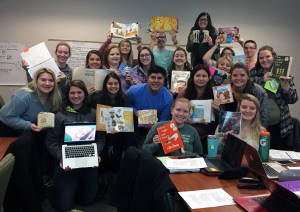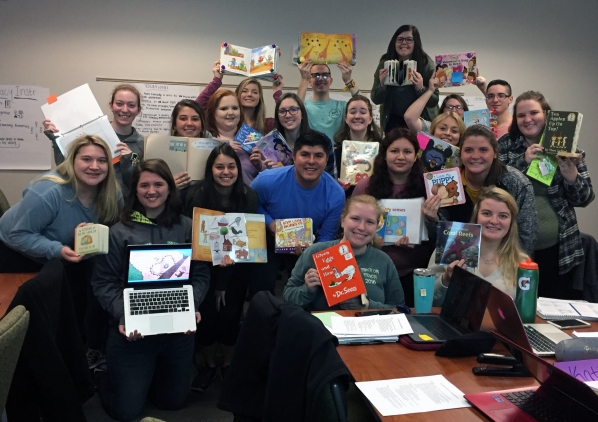This semester, Dr. Aftynne Cheek’s SPE 4410: Individualized Assessment and Curriculum students adapted some of their favorite books for students with severe disabilities. Cheek is an assistant professor in the Department of Reading Education and Special Education at Appalachian State University’s Reich College of Education. She teaches this course annually for students enrolled in Special Education: Adapted Curriculum (Block 1).
Using the content learned in the course about age and grade appropriate content and the Common Core Curriculum Extended Content standards, which provide a uniform set of learning standards specifically for students who have moderate or severe disabilities who may need modifications and adaptations to access grade level content, students were able to adapt one of their favorite books in a way that provided that provided physical and cognitive access to literature.
The books included:
- Valentine's Day is Here by Fisher Price Little People
- Mis Sentidos by Gladys Rosa-Mendosa
- Green Eggs and Ham by Dr. Seuss
- Brown Bear, Brown Bear, What do You See? by Eric Carle
- Alphabet Soup by Kate Banks
About how she selected a book to adapt, student Colleen McIndoe said, “When choosing what book I wanted to adapt, I thought a lot about my favorite childhood books and my mind went immediately to Dr. Seuss. Green Eggs and Ham, in particular, has numerous repeating parts that would make it easier for kids of all ability levels to participate and be active in reading it.”
“When choosing what book I wanted to adapt, I thought a lot about my favorite childhood books and my mind went immediately to Dr. Seuss. Green Eggs and Ham, in particular, has numerous repeating parts that would make it easier for kids of all ability levels to participate and be active in reading it.”
For many of students, this was the first time they attempted to adapt a book for a student with severe disabilities.
Each book was unique, creative, and designed with an individual with severe disabilities in mind! Some of the adaptations included:
- Adding page fluffers and popsicle sticks to facilitate students’ ability to turn the page;
- Laminating books for durability;
- Adding pictures to the pages for vocabulary instruction and to increase interaction;
- Adding puff paint, stickers and felt to pages for sensory input;
- Putting a book on PowerPoint so students can use technology to access text.
Student Emily Gergely added page fluffers to her selected book. She said, “My adaptations were simple but could help students in big ways with many different disabilities.”
“My adaptations were simple but could help students in big ways with many different disabilities.”
From their presentations and reflections, it was evident that each student learned a great deal from completing this assignment, including how much time it takes to adapt a book.
Hopefully, they will use the information learned from completing this assignment during their Block I field placement and throughout their careers!
Contributed by Dr. Aftynne Cheek

